- Heart Rate Equipment Support
How To Use Polar
The instructions in this section apply to Polar heart rate equipment.
Battery Information
Battery Type
The Polar Heart Rate Sensors take one CR2025, which is a 3-volt lithium coin cell battery.
Note: The Polar H1 Heart Rate Sensor was previously called the Polar Wearlink chest belt.
Battery Life
The battery should last about two years at one hour of use every day.
Battery Replacement
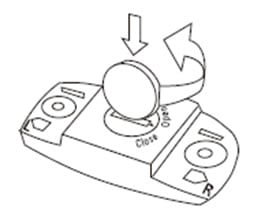
- Using a coin, open the battery cover by turning it counterclockwise to OPEN (see image at right).
- Insert the battery (CR2025) inside the cover with the positive (+) side against the cover. Make sure the sealing ring is in the groove to ensure water resistance.
- Press the cover back into the connector. Use the coin to turn the cover clockwise to CLOSE.
Installing the Concept2 Heart Rate Cable and Receiver
Concept2 Performance Monitors PM4, PM3 and PM2 must have the heart rate receiver interface installed in order to detect and display a heart rate transmitted from a Polar chest belt.
For Models B, C, or D Indoor Rowers, follow these instructions:
Heart Rate Receiver Installation on a Model B, C or D(PDF)
For Model E Indoor Rowers, follow these instructions:
Heart Rate Receiver Installation on a Model E(PDF)
Wearing the Polar Heart Rate Sensors
The electrode areas on the reverse side of the strap detect heart rate. The connector sends the heart rate signal to the Performance Monitor.
Note: The Polar H1 Heart Rate Sensor was previously called the Polar Wearlink chest belt.
To wear the chest belt:
Wet the electrode areas of the strap under running water and make sure that they are well moistened.
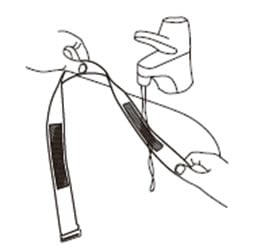
Attach the connector to the strap. Adjust the strap length to fit snugly and comfortably.
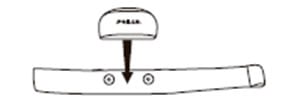
Tie the strap around your chest, just below the chest muscles, and attach the hook to the other end of the strap.
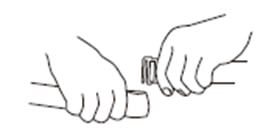
Check that the wet electrode areas are firmly against your skin and that the Polar logo of the connector is in a central, upright position.
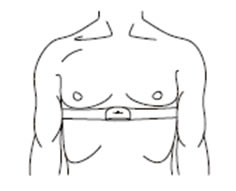
Additional Tips
Review the following tips to ensure successful heart rate transmission.
- If the chest belt is having trouble picking up your heart rate, try rotating the chest belt to the left side of your torso (closer to the heart). You can also try moving the chest belt higher or lower on your torso.
- Warm up, so that you are sweating a bit, before putting the chest belt on; this can help establish a connection between the skin and the contacts.
- Try using electrode gel on the contacts.
- Excessive body hair can degrade performance; shaving or moving the transmitter to a smoother area can help.
- Excessive body fat can block the signal from the chest belt. Position the transmitter in the leanest area possible, and avoid body parts, like the breasts, that are composed primarily of fatty tissue.
Cleaning the Polar Heart Rate Sensors
The following cleaning is recommended:
- After every use: Detach the transmitter connector from the strap and rinse only the strap under running water after every use. Dry the connector with a soft towel. Never use alcohol or any abrasive material (steel, wool or cleaning chemicals).
- After every fifth use: Wash the strap regularly in a washing machine in warm water or at least after every fifth use. This ensures reliable measurement and maximizes the life span of the transmitter. Use a washing pouch. Do not soak, spin-dry, iron, dry clean or bleach the strap. Do not use detergent with bleach or fabric softener. Never put the transmitter connector in the washing machine or dryer!
Note: The Polar H1 Heart Rate Sensor was previously called the Polar Wearlink chest belt.
Storing the Polar Heart Rate Sensors
Dry and store the strap and connector separately, to maximize the transmitter battery lifetime. Wash the strap in a washing machine before long-term storage, and always after use in pool water with high chlorine content.
Keep the transmitter in a cool and dry place. Do not store wet in non-breathing material, such as a sports bag. Sweat and moisture keep the electrodes wet and activated. Do not expose to direct sunlight for extended periods.
Note: The Polar H1 Heart Rate Sensor was previously called the Polar Wearlink chest belt.
Pairing a Chest Belt with a PM4 or PM5
Before the Performance Monitor (PM) can detect your heart rate from a chest belt, you need to pair the ID of the chest belt with your PM. If you use a LogCard or USB flash drive with your PM, your chest belt ID can be saved to that device, so you should only have to perform this pairing once. If you do not use a LogCard or USB flash drive with your PM, you will need to repeat the pairing process every time you row or ski.
Before attempting to pair a chest belt with a PM4 or PM5, please ensure you are using compatible equipment.
Pairing Without a LogCard or USB Flash Drive
- Put the chest belt on, and press any button on the Performance Monitor (PM) to power it up.
- On the Main Menu, select Connect. For PM4s, or PM5s running old firmware, select More Options instead.
- Select Connect Heart Rate. Within 5–10 seconds, the PM will list identification information for any chest belt it finds. This information may include brand or model information and/or an ID number.
- Choose the ID that corresponds to your chest belt. (If you are unsure, check the chest belt ID, which is typically listed on the back of the belt.)
- Select Confirm Selection.
Pairing while connected to the ErgData application
- Put the chest belt on, and press any button on the Performance Monitor (PM) to power it up.
- Connect ErgData to the PM.
- Select Connect Heart Rate. Within 5-10 seconds, the PM will list identification information for any chest belt it finds. This information may include brand or model information and/or and ID number.
- Choose the ID that corresponds to your chest belt. (If you are unsure, check the chest belt ID, which is typically listed on the back of the belt.)
- Select Confirm Selection.
- On the ErgData app, select Yes to, "Remember Heart Rate Belt?"
This saves your chest belt’s ID to your ErgData application so that the PM automatically detects your chest belt in the future.
Pairing with a LogCard or USB Flash Drive
- Put the chest belt on, and press any button on the Performance Monitor (PM) to power it up.
- Insert your LogCard or USB flash drive into the monitor.
- Important: If you are using a USB flash drive, wait for the PM to display the Welcome screen with your user name before moving to the next step.
- On the Main Menu, select Connect. For PM4s, or PM5s running old firmware, select More Options instead.
- Select Connect Heart Rate. Within 5–10 seconds, the PM will list identification information of any chest belt it finds. This information may include brand or model information and/or an ID number.
- Choose the ID that corresponds to your chest belt. (If you are unsure, check the chest belt ID, which is typically listed on the back of the belt.)
- Select Remember Belt. This saves your chest belt's ID to your LogCard/USB flash drive so that the PM automatically detects your chest belt in the future.
Stay connected